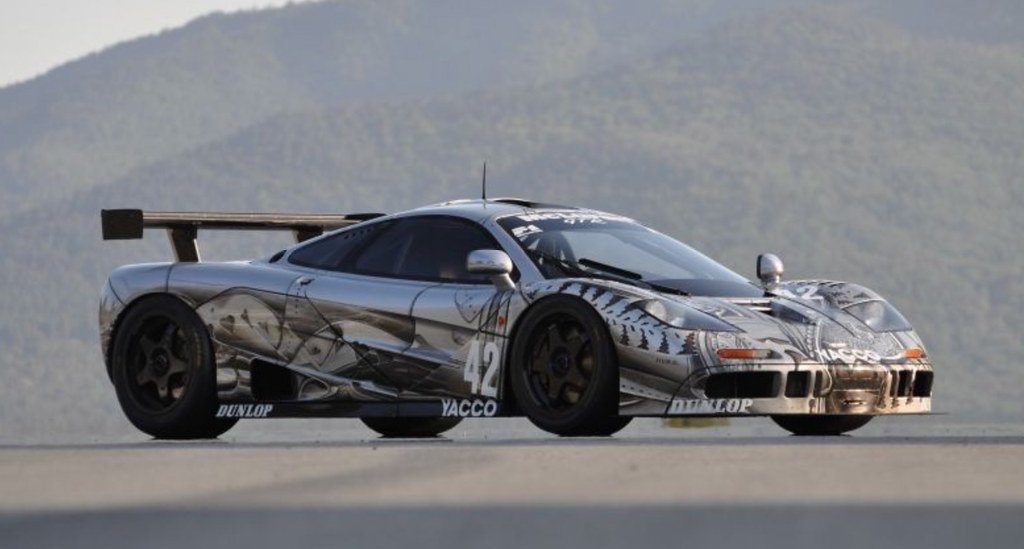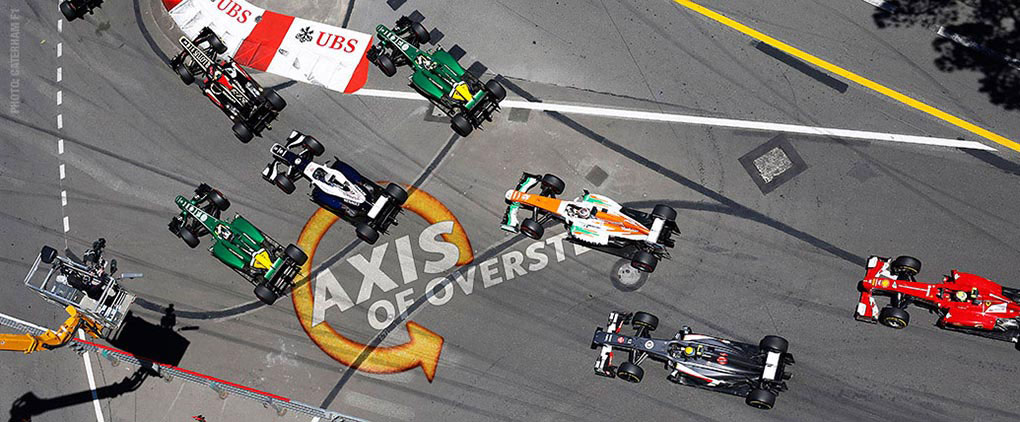
Is going on sale July 9th in Le Mans at the Artcurial auction house of the same Hervé Poulain originally responsible for convincing BMW to create its celebrated series on mobile sculptures. Poulain was also one of the drivers of this car when it scored a 13th overall in the 1995 edition of the French classic.
The artist, César, was known for exhibiting cars pressed into cubes in the early 60's and his concept here was to paint flattened LeMans trophies. “I have compressed your vanity but increased your glory.” César said at the time.
Check out the rest of the auction, incredible cars and memorabilia pieces going on the block.
Read the full description and history after the jump
(Artcurial via SportscarDigest)
Series N°: 005
Engine: 60° BMW V-12 cylinder, aluminium alloy block & head, central rear position (type BMW Motorsport S 70/3 GTR)
Capacity: 6064cc
Maximum power: 640hp at 6750rpm
Chassis: carbon monocoque with power-unit 15mm lower than for road car
Bodywork: composite carbon fibre with tubular steel protective cage
Performance: top speed of approx. 360km/h (225mph)
In 1992 the inventive, charismatic Stéphane Ratel appeared in the world of motor racing, convincing French makers Venturi to build a 400hp model for members of the international jet-set keen to take part in the Gentlemen Drivers Trophy. This Pro-Am concept, involving amateur/ professional teams, was so successful that, along with Jürgen Barth and Patrick Peter, Ratel launched the BPR Global GT Series (named after the initials of its founders' surnames) in 1995.
At the same time, McLaren Cars Ltd, created in 1989 to perpetuate the dreams of Bruce McLaren, began producing the road car of the future.
Gordon Murray (on temporary leave from Formula 1) and Peter Stevens designed an aesthetic masterpiece powered by a magnificent BMW engine - thanks to the good relations the engineer enjoyed with the Munich firm after collaborating in Nelson Piquet's Formula 1 championship victory.
The Supercar was unveiled to the public for the first time during the curtain-raiser to the 1992 Monaco Grand Prix. The original interior had a central steering-wheel with passenger seats set slightly back to either side.
Performances were so impressive - with a top speed of 225mph - that Ron Dennis and Gordon Murray welcomed the idea of targeting selected high-end clients: hence the construction of a GTR racing version, geared for the new BPR championship and ultimately the Le Mans 24 Hours.
A first series of seven cars (chassis numbers 1 to 7) were built for the 1995 season:
Chassis 1: prototype, owned by McLaren Cars, winner of the Le Mans 24 Hours in
March 1995 (driven by Dalmas/ Lehto/ Sekiya); now property of
McLaren Cars
Chassis 2: driven by Belm/ Sala for GTC Motorsport, sponsored by Gulf Oil
Chassis 3: sold to Thomas Bscher, driven by Bscher/ Nielsen for West Competition
(David Price Racing), sponsored by Cigarettes West
Chassis 4: sold to Lindsey Owen-Jones, driven by Owen-Jones/ Raphanel for GTC Motorsport, sponsored by Gulf Oil
Chassis 5: sold to industrialist Jean-Luc Maury-Laribière, entered by BBA Competition
(Team Noel Del Bello), sponsored by Tuiles TBF
Chassis 6: sold to the Al Fayed family, driven by Grouillard/ Wallace/ Bell for Rack One Racing (David Price Racing), sponsored by Harrods
Chassis 7: sold to Mr Picard, driven by Giroix/ Grouillard/ Deletraz for Jacadi Racing, sponsored by Elf 2 Jacadi
Chassis number 5 was acquired by Jean-Luc Maury-Laribière - an industrialist from south-west France, defending the colours of his tile-making company TBF - who had taken part in the Venturi Trophy in 1992, 1993 and 1994, and in the 1994 Le Mans 24 Hours, behind the wheel of a Venturi 500 LM.
Irrespective of its history and track record, this McLaren is of especial note as a member of the ArtCar Pantheon: it was decorated for the 1995 Le Mans 24 Hours by one of the most famous members of the Pop Art movement - the sculptor César.
THE ARTCAR CONCEPT
In the car-unfriendly context of the first oil crisis, auctioneer Hervé Poulain - a man 'mad about speed and beauty' - came up with the utterly novel idea of taking part in the 1975 Le Mans 24 Hours in a racing car painted by an internationally famous artist.
His vision encompassed the nobility of a racing car as an artistic support, with its powerful, wind-defined forms; the drama of motor racing; and the stature of the artist concerned.
Poulain aimed to take up the time-honoured, yet hitherto abortive, idea of associating Art and Industry - and offer an original gift to spectators at the world's most prestigious car race. The legendary Le Mans circuit lends itself perfectly to metaphor and catharsis; as once on Mount Olympus, the heart of the world beats here - every year for a day and a night.
With the backing of BMW Motorsport and its Competitions Director Jochen Neerpasch, the ArtCar concept was born.
Alexander Calder (1975), Frank Stella (1976), Roy Lichtenstein (1977) and Andy Warhol (1979) painted the first BMWs to be driven by Hervé Poulain at Le Mans, before the German carmakers abandoned endurance races in favour of Formula 1. Poulain later revived the concept, driving a Venturi 600 LM decorated by Arman at Le Mans in 1994; the McLaren F1 GTR Chassis n°5, painted by César, in 1995; and a Porsche GT2 painted by Wolinski in 1998.
This year BMW and Hervé Poulain are teaming up again, unveiling the latest ArtCar - painted by star American artist Jeff Koons - at the Pompidou Centre on May 30. The car will be competing in the 2010 Le Mans Classic on July 10/11.
POP ART
In reaction to the dominance of abstract art, pop culture - inspired by the everyday reality of the booming Consumer Society - caught the imagination on both sides of the Atlantic in the early 1960s.
American artists such as Lichtenstein, Warhol, Rauschenberg, Jasper Jones, Rosenquist and Wesselman tended to celebrate the new way of life; but artists in Paris - whether belonging to the Figuration Narrative (Erro, Adami, Rancillac, Télémaque, Klasen, Monory) or Nouveaux Réalistes movements - were more prone to denounce its contradictions and abuses.
In 1960 the celebrated French art critic Pierre Restany created the Nouveaux Réalistes movement, uniting a number of artists who appropriated and recycled industrial products - including Arman's accumulations of household waste; Tinguely's animated iron contraptions; the torn posters beloved of Hains, Villeglé and Rotella; Christo's packaging; Yves Klein's blue; Niki de Saint-Phalle's Nanas; and Spoerri's reliefs of meal remains.
The most popular member of the group was and remains César, 'the first man in the history of art and sculpture to use a machine-tool to produce a work of art.'
CESAR'S CHARIOT
César caused a sensation by exhibiting solid blocks of compressed cars at the Salon de Mai in 1960. An heir to Rodin and Giacometti, forerunner of John Chamberlain and soul-mate of Germaine Richier and Louise Bourgeois, César built on the ensuing scandal to pursue the history of sculpture by other means. With his Compressions, he invented a language without precedent or possible lineage.
His choice of cars was considered far from innocent - as if he were getting his own back on the cult object of the Consumer Society and its pollution, waste, accidents and traffic-jams. César, however, always claimed he was inspired solely by the aesthetics of crushed coloured metal - and that, at the time, he didn't have the money to cast bronzes, let alone carve marble …
His international reputation, however, was already established, as a whole room had been devoted to his work at the 1956 Venice Biennale - eight years before Rauschenberg received his Gran Premio there!
Thirty-five years after the iconoclastic gesture of his first compression, 10 years after his Peugeot compression Les Championnes, and just months after again representing France at the 46th Venice Biennale with a mountainous 24ft-high compression weighing 520 tonnes, César's automobile odyssey drew to a conclusion with the painting of the McLaren F1 GTR BMW ArtCar, whose drivers included Hervé Poulain.
Back in 1982, after making an initial farewell to competition, auctioneer Poulain had given César all the trophies he had won for rally-driving and at Le Mans. César transformed them into two gleaming compressions, saying: 'I have compressed your vanity but increased your glory.' And, indeed, César's compressions are to our contemporary mentalities what Vanity paintings were to men of the 17th century: a reflection on the insignificance of riches and the precarious nature of passion.
César's made a trompe l'œil print of these compressions when designing his ArtCar, explaining: 'It's rather like protective armour - in memory of the Riches Heures you've enjoyed at Le Mans.' César duly received a Roman triumph when he joined the three drivers at the pre-race parade!
Maury-Laribière was behind the wheel at the start, but pulled up after half-an-hour because of gear-box trouble. He set off again at 5.08pm. As evening drew in, the rains came down. Maury and Marc Sourd battled through the night, climbing from 44th to 17th by halfway. I happened to be at the wheel on the Sunday morning, just as television coverage was starting. Gounon's Venturi attacked me as we approached the Dunlop footbridge. In panic, my four wheels skidded on the wet surface and embarked me on some sort of ballet solo. It wasn't my life that flashed before the eyes, but a close-up of my horrified team-mates! I hit the brakes. The McLaren seemed to stabilize, pirouetting back-to-front on the track. Whew! The car made a second salto and I again blocked the wheels, now finding myself facing in the right direction. Not without luck, I had performed a manœuvre worthy of driving school. Relief was stronger than vanity - relief at avoiding the 'compression' of my precious $1 million McLaren (not counting the paintwork)… Back in the stalls, we fêted our 13th place and the team joked about my free-skating routine shown live on TV…
- Hervé Poulain (1995)
McLAREN F1 GTR Chassis n°5 - RESULTS
1995
Paul Ricard: 5th - Fabre/ Maury-Laribière/ Lecuyer
Monza: 8th - Fabre/ Maury-Laribière/ Lecuyer
Paris-Montlhéry: abandoned (3rd fastest in practice) - Sourd/ Maury-Laribière/ Lecuyer
Susuka: 11th - Maury-Laribière/ Libert/ Harada
Le Mans: 13th - Sourd/ Maury-Laribière/ Poulain
1996
Paul Ricard: 10th - Sourd/ Maury-Laribière/ Hugenholtz
Monza: abandoned - Sourd/ Maury-Laribière/ Hugenholtz
Jarama: 22nd - Maury-Laribière/ Hugenholtz/ Camp
Silverstone: 16th - Maury-Laribière/ Hugenholtz/ Vosse
Nürburgring: 11th - Maury-Laribière/ Hugenholtz
Anderstorp: abandoned (11th fastest in practice) - Clerico/ Maury-Laribière
Susuka: abandoned (14th fastest in practice) - Clerico/ Maury-Laribière/ Libert
Spa: 21st - Maury-Laribière/ Libert/ Hugenholtz
Nogaro: abandoned (10th fastest in practice) - Grouillard/ Maury-Laribière
1997
Hockenheim: 14th - Thévenin/ Maury-Laribière
Nürburgring: 17th - Maury-Laribière/ Velay
Spa: 22nd - Maury-Laribière/ Velay/ Chauvin
Susuka: abandoned - Maury-Laribière/ Harada/ Yoshikawa
In line with the initial spirit of the BPR Championship, the car was driven by amateurs assisted by a professional, who varied according to the type of race: Pascal Fabre (F1), Emmanuel Clerico (F3000), Olivier Grouillard (F1), Marc Sourd (French Supertouring Champion).
At the Le Mans 24 Hours in 1996, Maury-Laribière teamed up with former Indy 500 Champion Arie Luyendyk and Le Mans 24 Hours winner Stanley Dickens. Sadly the splendid McLaren failed to qualify after sustaining damage during practice.
Later the car was sold to a businessman who had taken part in the 1997 Lamborghini Trophy. He did not enter the N°5 for any races, but meticulously maintained it so he could drive it at circuits whenever he felt like it.
Like many demanding connoisseurs, we believe that the first seven GTRs, built for the BPR 1995 season, remain the finest and purest - reflecting Gordon Murray's creative genius without correction or addition.

No comments:
Post a Comment